How to grow zinnias – plant, care and maintenance tips
Find out how to grow zinnias to brighten up your garden and bring both color and wildlife with these summer flowers
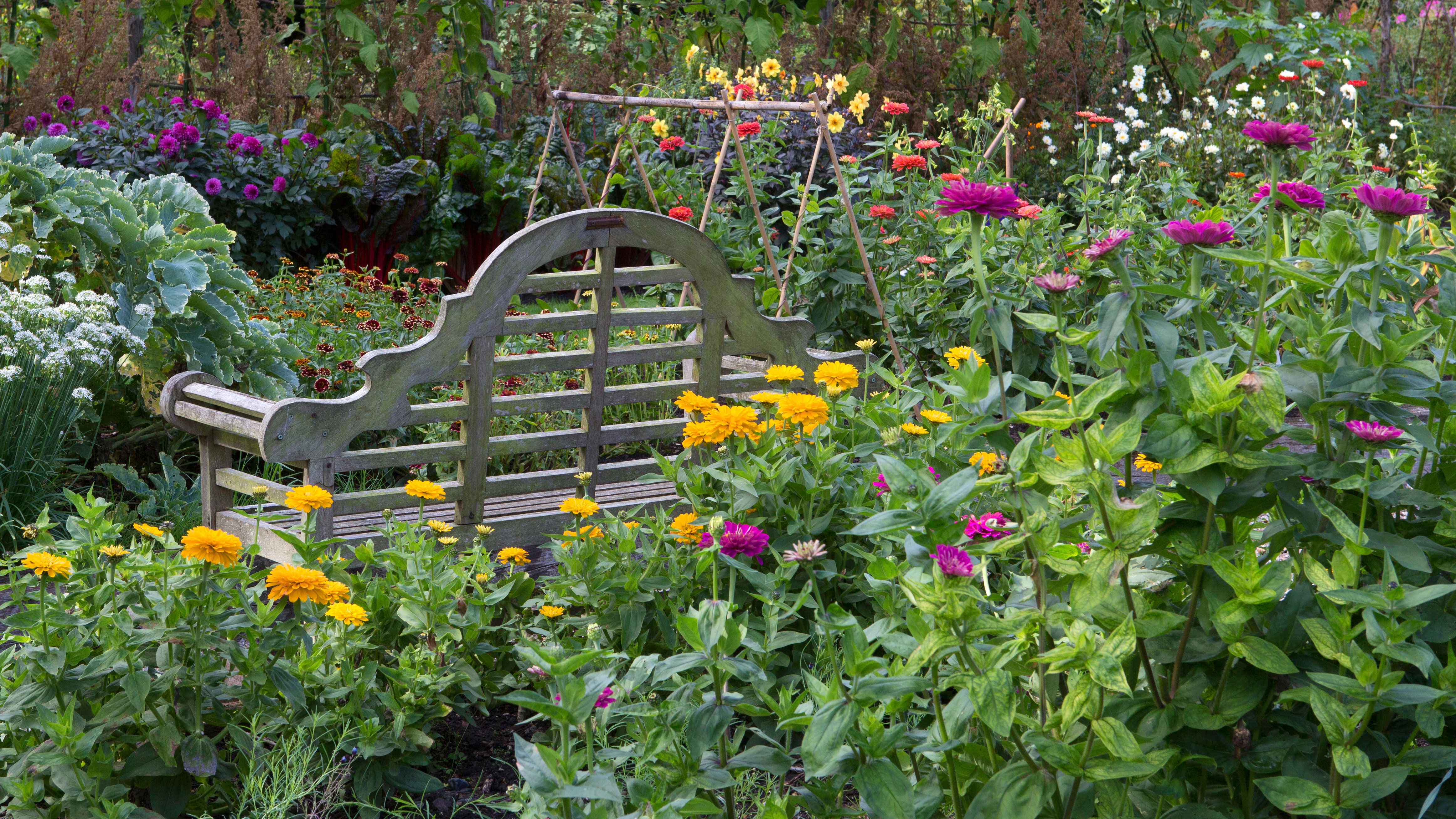

Leigh Clapp
Any gardener should learn how to grow zinnias, as they are one of the quickest and easiest summer flowers to grow, as well as being colorful, dazzling, versatile, drought tolerant, ideal cut flowers – to name but a few of their attributes.
Closely related to the sunflower and part of the daisy family, Zinnia elegans are half-hardy annual flowering plants, native to the Southwestern states and Mexico.
Not only are zinnias a firm favorite in our flower bed ideas, but single-flowered varieties are also loved by wildlife including bees, butterflies and ladybirds. There are also semi-double, double and rounded pompom and cactus shapes to discover, with compact and tall varieties.
Growing zinnias is an easy way to add beauty and vivid colors to your flower beds as part of your garden ideas.
Read on to find out how to grow zinnias in your own garden for statement blooms throughout the summer season.
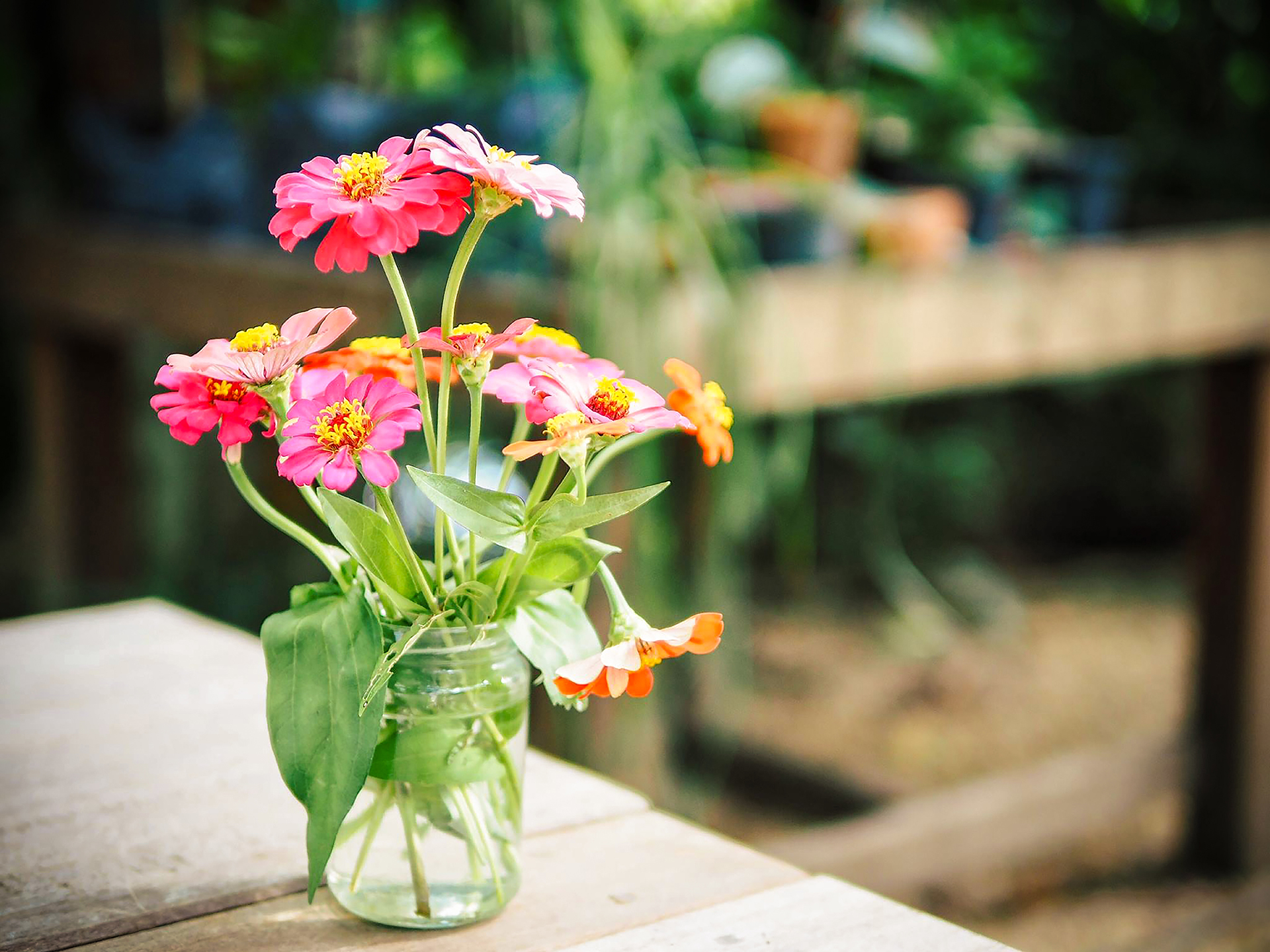
How to grow zinnias for beginners
When it comes to advice on how to grow zinnias, author and garden expert Melinda Myers recommends 'full sun and well-drained soil. Once established they are drought tolerant making them an excellent choice for containers and busy gardeners.'
If you're wondering how to plant a flower bed with zinnias, there are a number of options: you can sow seeds direct outdoors; sow seeds into modules or seed trays; or buy plug plants to plant out.
However, there are some key rules to follow in order to produce successful blooms. Zinnias dislike being transplanted or having their roots disturbed so should be sown in the ground where you want them to grow. Knowing when to plant zinnia seeds will ensure success, too.
‘Zinnias don't like root disturbance or cold nights, so direct sow the seeds when the nights are warm enough to sit outside in the evening,’ says expert plantswoman Sarah Raven. The timing for this will differ depending on if you live in a cooler or warmer region – about late May early June in cooler climates.
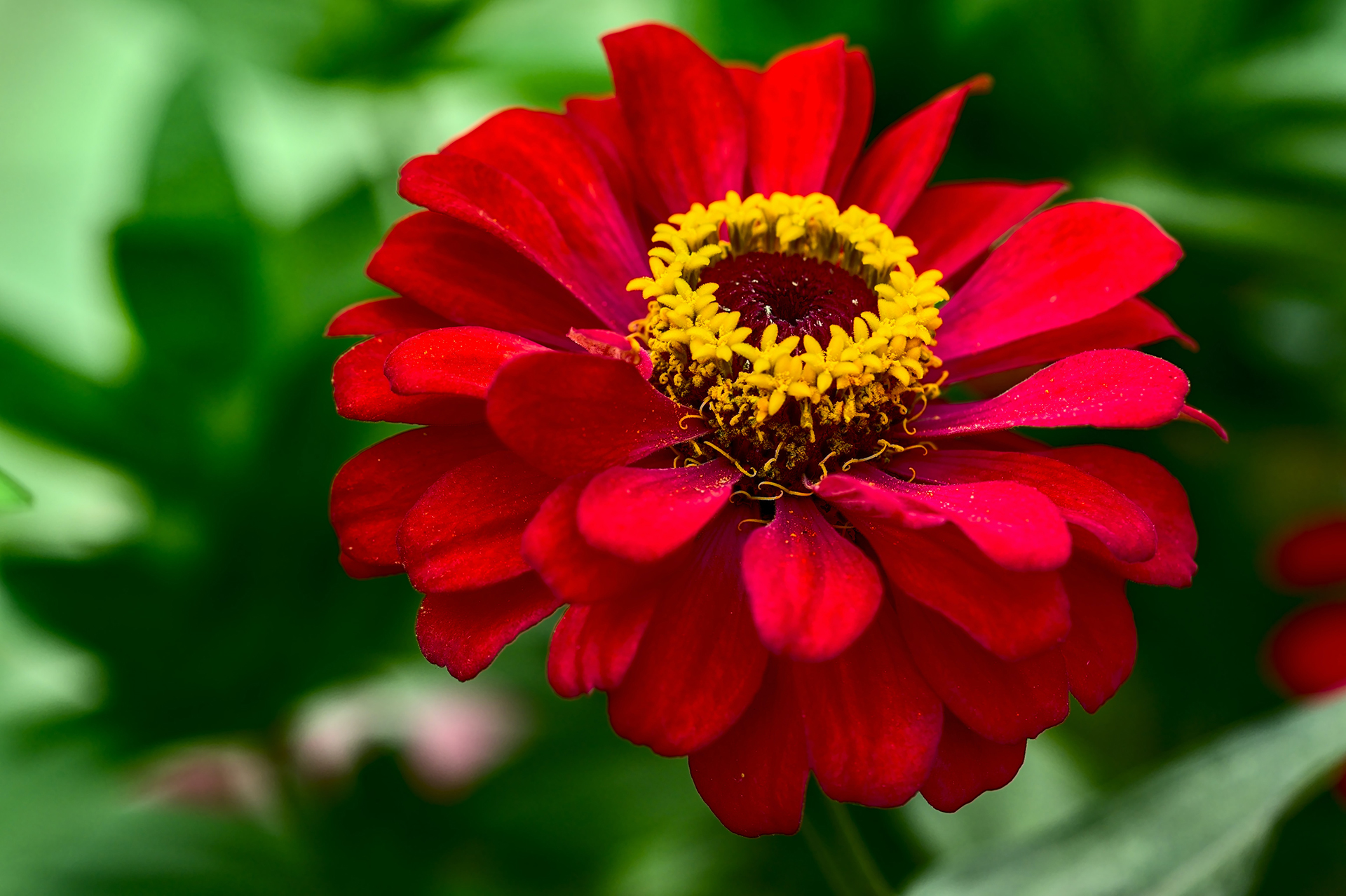
What is the best way to grow zinnias?
If you choose to direct sow zinnia seeds into the ground outside, 'simply direct sow the seeds in a sunny spot after the last frost. Add a couple inches of mulch or compost and a bit of fertilizer,' advises Kristin Winterbottom from Parkseed.
One of the most common mistakes when growing zinnias is planting them too early. Zinnias won't survive any frost, so only sow your seeds once all risk of frost is over and the cooler nights have passed.
The better the soil, the taller zinnias will grow, and they like some space to spread. Prepare the bed by raking over, check the seed packet for spacing and then cover with a thin layer of soil. As the seedlings grow, thin them out carefully to around 15in (40cm) apart.
'Keep the soil moist by watering at the base of the plants. Cut blooms frequently for arrangements or simply pinch off spent blooms,' adds Kristin.
Stake taller varieties with canes or twig supports and that way they will also flower better.
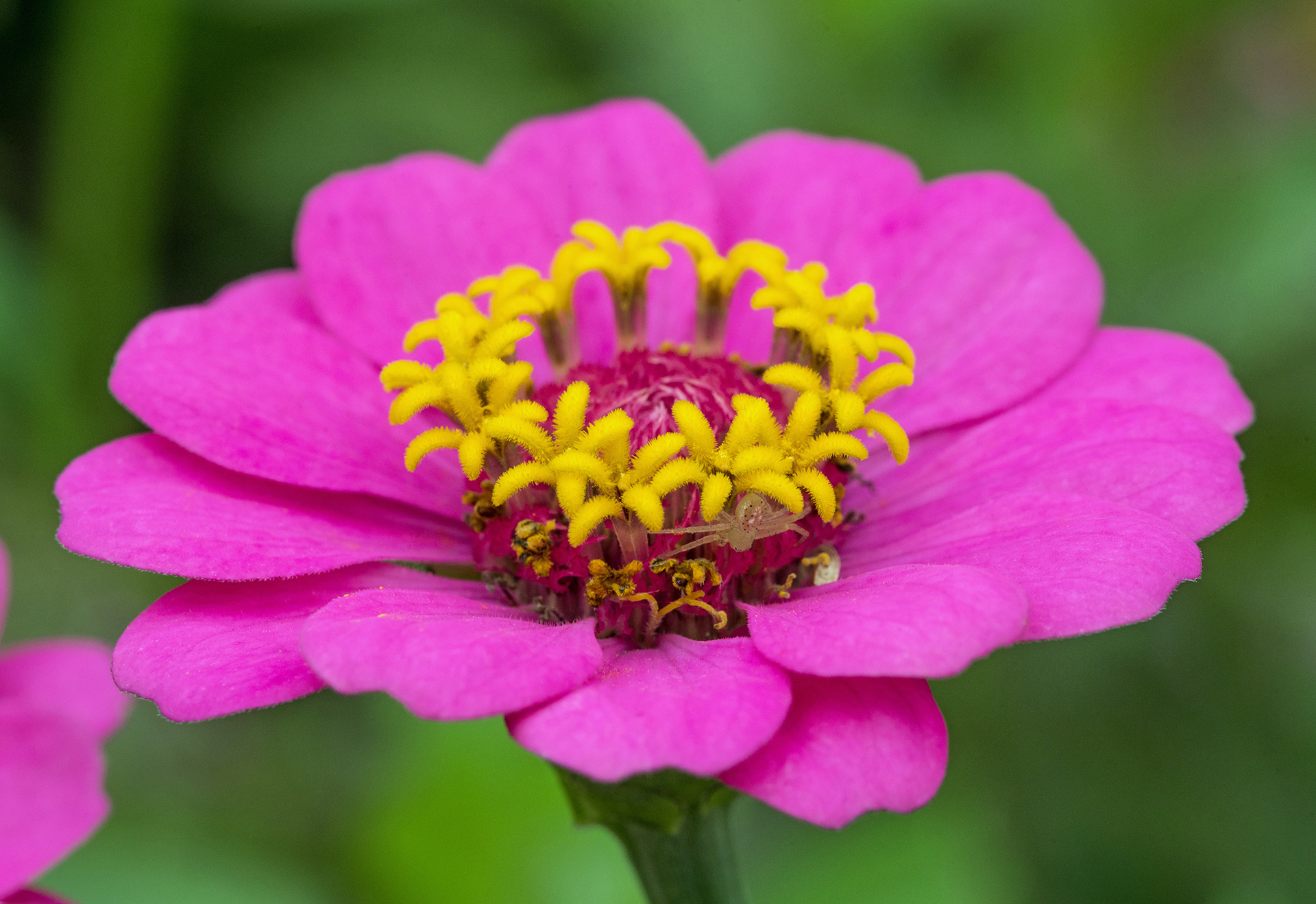
‘Alternatively you can sow zinnias into modules or seed trays, so there is no pricking out, and plant out when still small with only a pair or two of true leaves. That way you minimize root handling,’ recommends Sarah Raven.
If you're wondering 'should I soak zinnia seeds before planting?' then the answer is yes. Soaking your seeds will increase the speed of propagation. However, you need to be careful not to leave the seed in water for too long as the seed will start to rot. Soak your seed for between 8-12 hours.
The easiest way to grow zinnias, or if you're short on time, may be to buy them as plug plants, and grow in individual pots before planting out.
Where is the best place to plant zinnias?
Zinnias require plenty of sunlight in moderately fertile, well-drained soil and dislike waterlogging. Originating from South-Western America and Mexico, zinnias thrive in warm climates. If you live in a cooler part of the world, then growing them undercover in a greenhouse will offer more success.
When growing zinnias, plant them in a group for an eye-catching, colorful display from late summer into fall and the first frost. This is also a flower that attract bees – if they are dotted throughout for a beautiful wildlife garden idea.
With their bright, vivid colors, zinnias brighten up any area of the garden and suit a range of styles. They are a good choice for cottage garden plants, wildflower meadows, prairie planting and cutting garden flowers. They are also ideal for children to grow in containers or on their own little patch.
‘We plant zinnias with our vegetables. Zinnias are amazing as plant partners, attracting pollinators, and bees love them,’ says Bridget Elworthy of The Land Gardeners, so they are a good choice if you're considering companion planting.
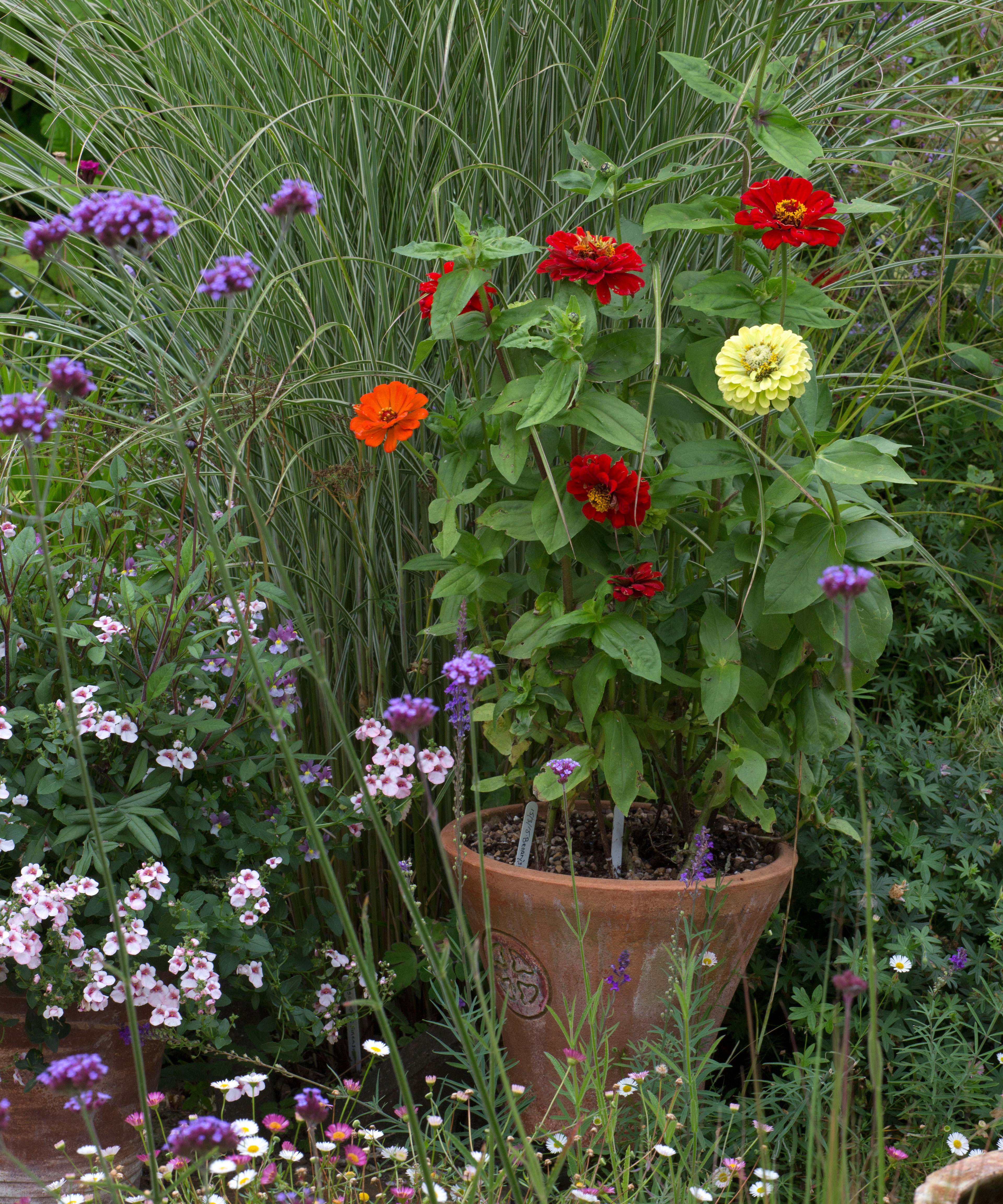
Do zinnias do well in pots?
Zinnias do well in pots and make very attractive and colorful container gardening ideas.
Use a light potting mix in pots with good drainage and only place your pot outside when the frost is over. If you are growing your zinnias in pots, you can sow them earlier if you have a warm greenhouse in which they can germinate and start to grow.
Place the containers in a sunny spot, water your zinnias in pots regularly, and feed with a liquid fertilizer every few weeks during summer.
How to grow zinnias from cuttings
Growing zinnias from cuttings is an excellent way to duplicate your favorite plants, although these have less success than growing straight from seed.
Take cuttings from zinnias the same way you would with any other tender annual – cut around 2½-3 inches of leaf and stems and put in a small pot of two-third compost and one-third grit. Water well and place in a warm spot – either the greenhouse or a windowsill – and your cutting should root with two-three weeks.
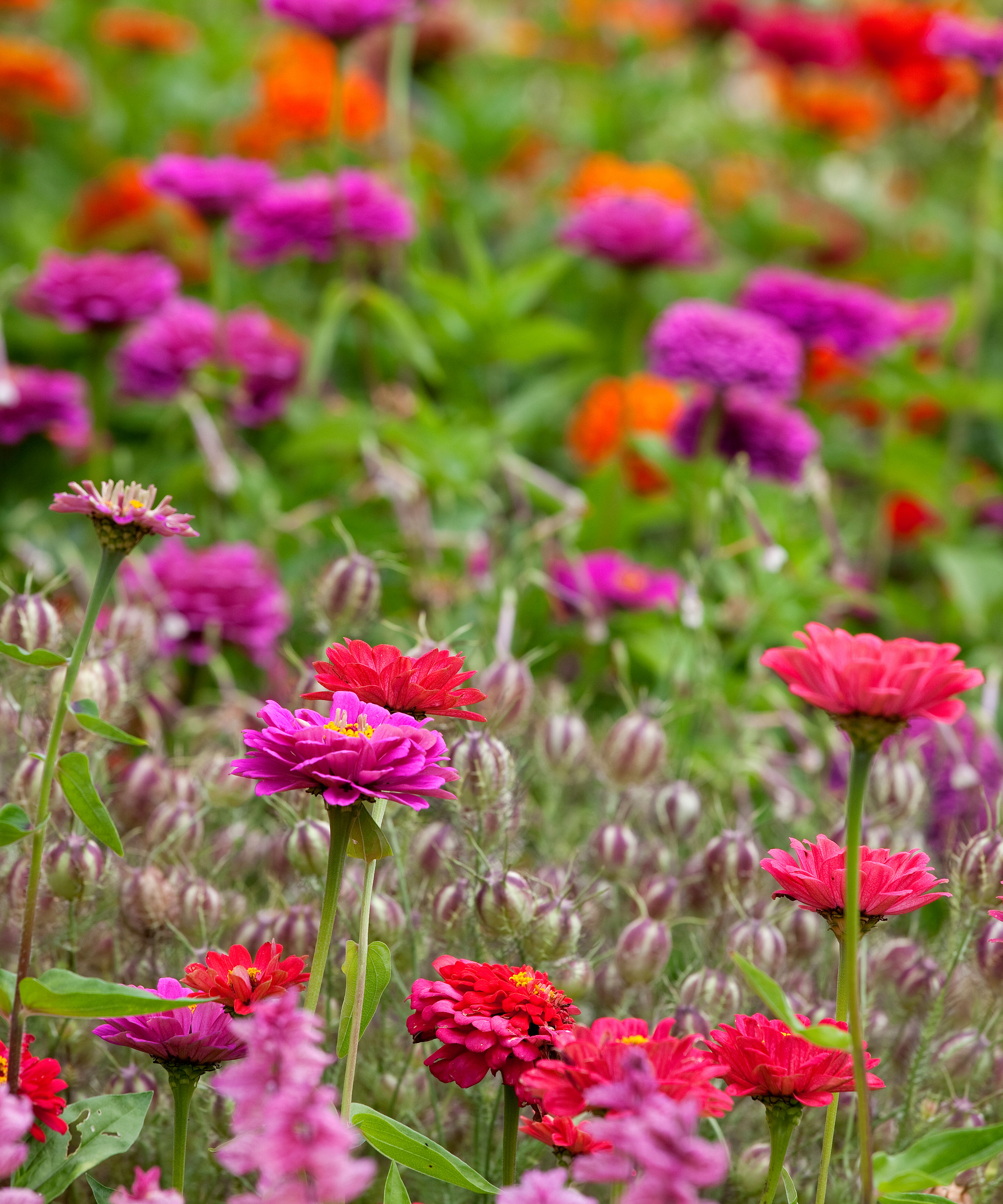
Do zinnias come back every year?
No, zinnias don't come back every year as they are annual plants. This means that the flowers complete their entire life cycle in one year.
Zinnias are very vulnerable to frosts and will die soon after the first frost. If you want to have the flowers in your garden every year, then you will have to resow annually, or let some of the zinnias flowers die naturally and fall to the ground so that they germinate seeds by themselves.
To collect and save seed from the flowers to sow next spring:
- Let the flowers go brown
- Snip off the flowers
- Holding a bag underneath, gently shake and rub loose the seeds
- Save in labelled seed envelopes for sowing next spring or summer
Since zinnias are so easy and low-maintenance to grow it's not too much trouble, especially for the reward of the beautiful blooms come in the late summer months.
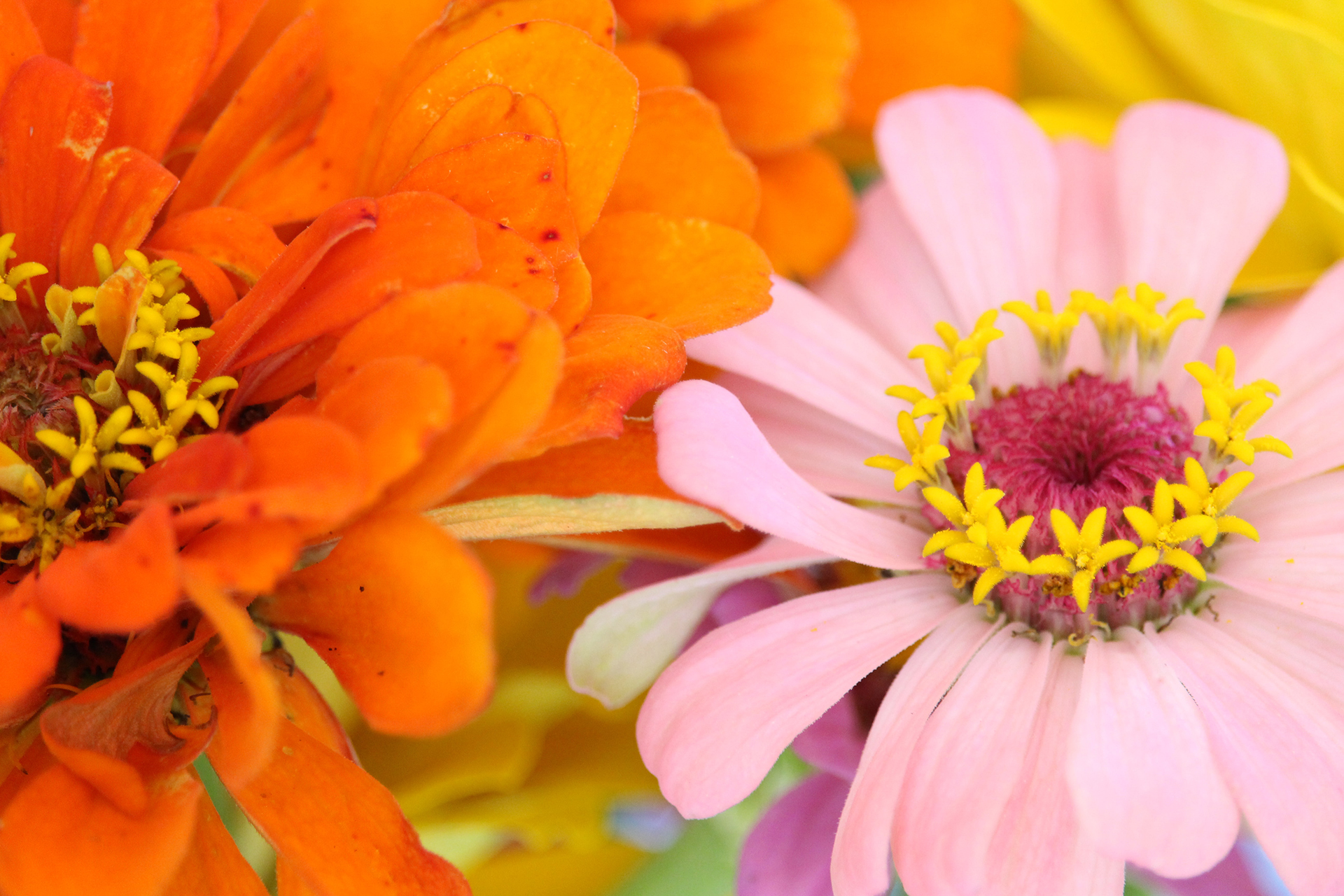
How to grow zinnias for a wildlife garden
Zinnias are loved by bees and butterflies. 'Blooming in the late summer and early fall, these pretty flowers will add some delightful color to your garden in the late season and keep the bees returning for months,' says Lucia Polla of Serenata Flowers..
Underplant zinnias with petunias and Erigeron karvinskianus, which also thrive in hot, full-sun conditions, to offer a real smörgåsbord for any visiting critters.
Zinnias suffer from few pest problems, and planting them among vegetables and herbs, intermingling with marigolds and nasturtiums, will actually help the balance of beneficial insects.
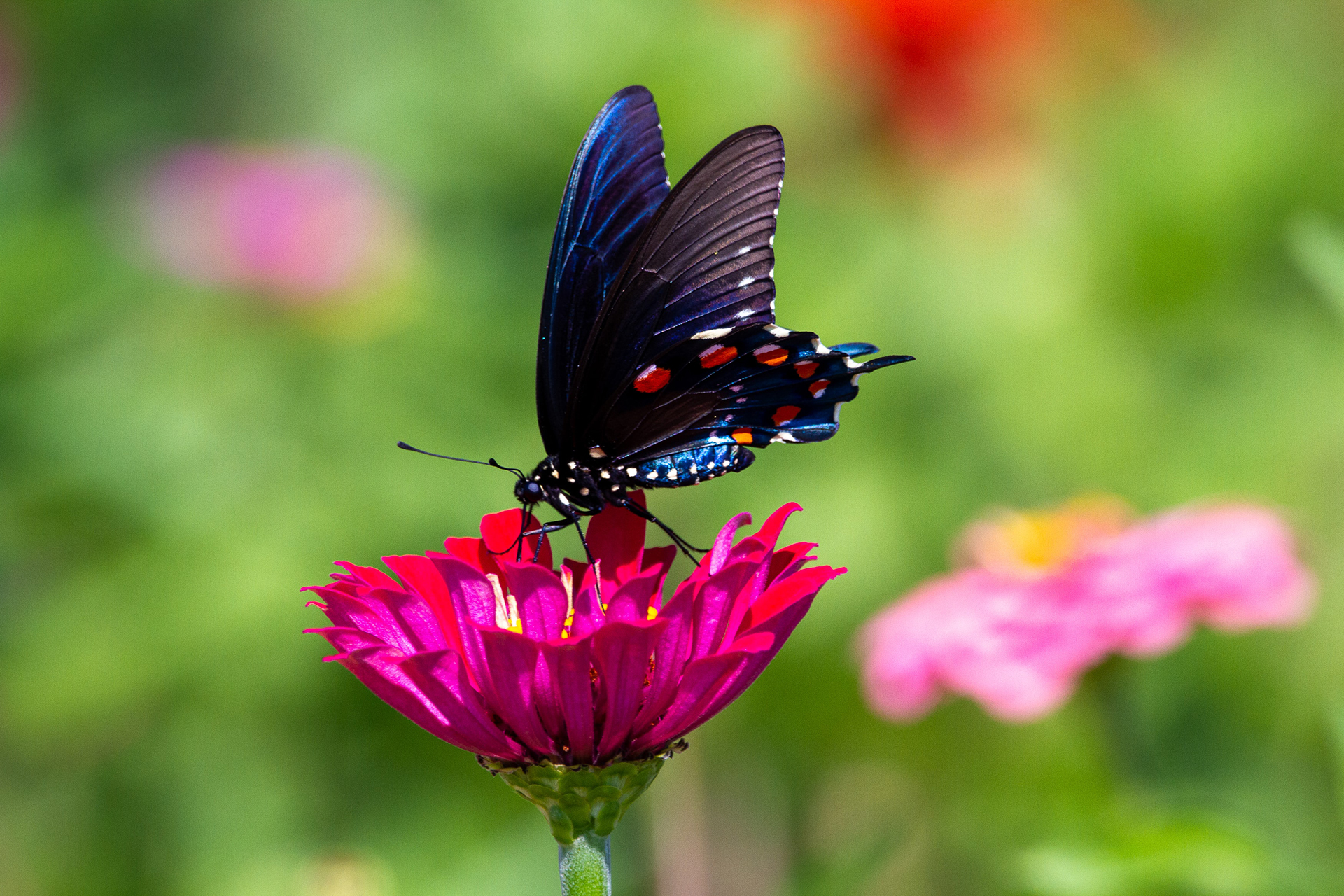
Do I need to pinch out zinnias?
You can pinch out zinnias to promote a strong and healthy plant. By pinching out the growth tip early on in the season will encourage the plant to branch out and create more flower stems.
However, it is not essential that you pinch out zinnias. They will naturally branch out throughout the season, especially when you are deadheading or cutting flowers for the vase as this has a similar effect.
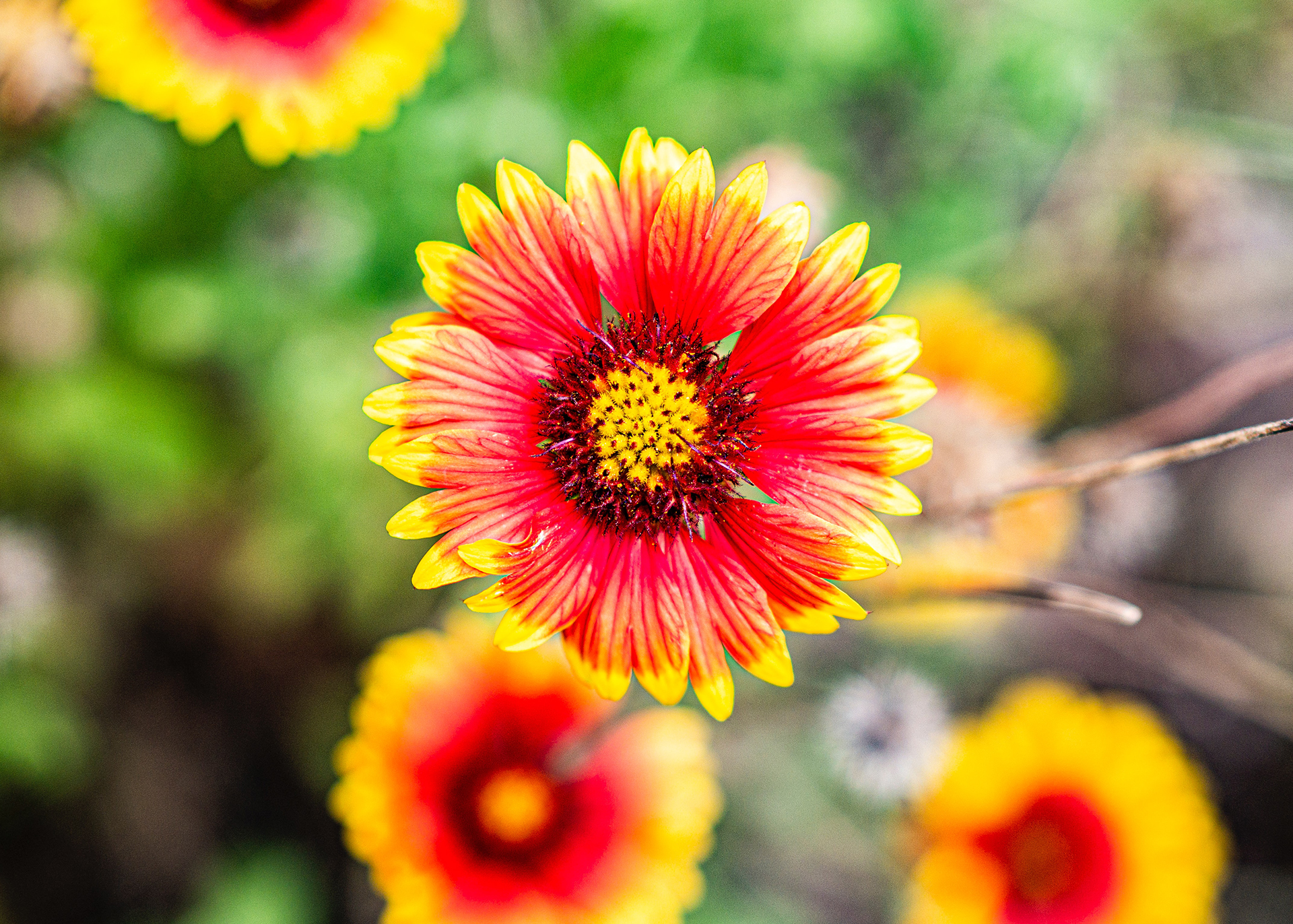
How to grow zinnias as cut flowers
If you’re looking for blooms to use when planning a cut flower garden then zinnias are definitely ones to include. Producing a long stemmed solitary flower in a wide range of colors from white and yellow through to orange, red, purple and lilac, zinnias are great cut flower bloom.
‘Zinnias are as lovely in a vase as they are growing in the garden and there are some excellent compact varieties, too,' says Sarah Raven.
'Nothing says summer like a handful of cheerful zinnias. They are one of the easiest cut flowers to grow, thrive in heat and the more you pick them the more they bloom. They are perfect for beginning gardeners,' says Erin Benzakein author and founder of Floret Flowers.
For cut flowers, harvest your blooms when they are beginning to unfurl in the morning as this is when there will be the most moisture making them less likely to wilt. Plunge the blooms into a bucket of warm water, stripping off lower leaves to avoid them in the water. Re-cut the stems regularly and refresh the water and they should last up to 10 days in the vase.

Do zinnias grow back after cutting?
Yes zinnias do grow back after cutting. They make a good cut flower that keeps on giving the more you cut and lasts well in the vase.
You should deadhead your zinnias to keep them flowering throughout the whole season. You can either deadhead the blooms as they start to fade, or you can cut them off slightly earlier and then display them in a vase to get double the pleasure from your plants.
If cutting for the vase, select stiff stems and pick them just as the buds are beginning to open.
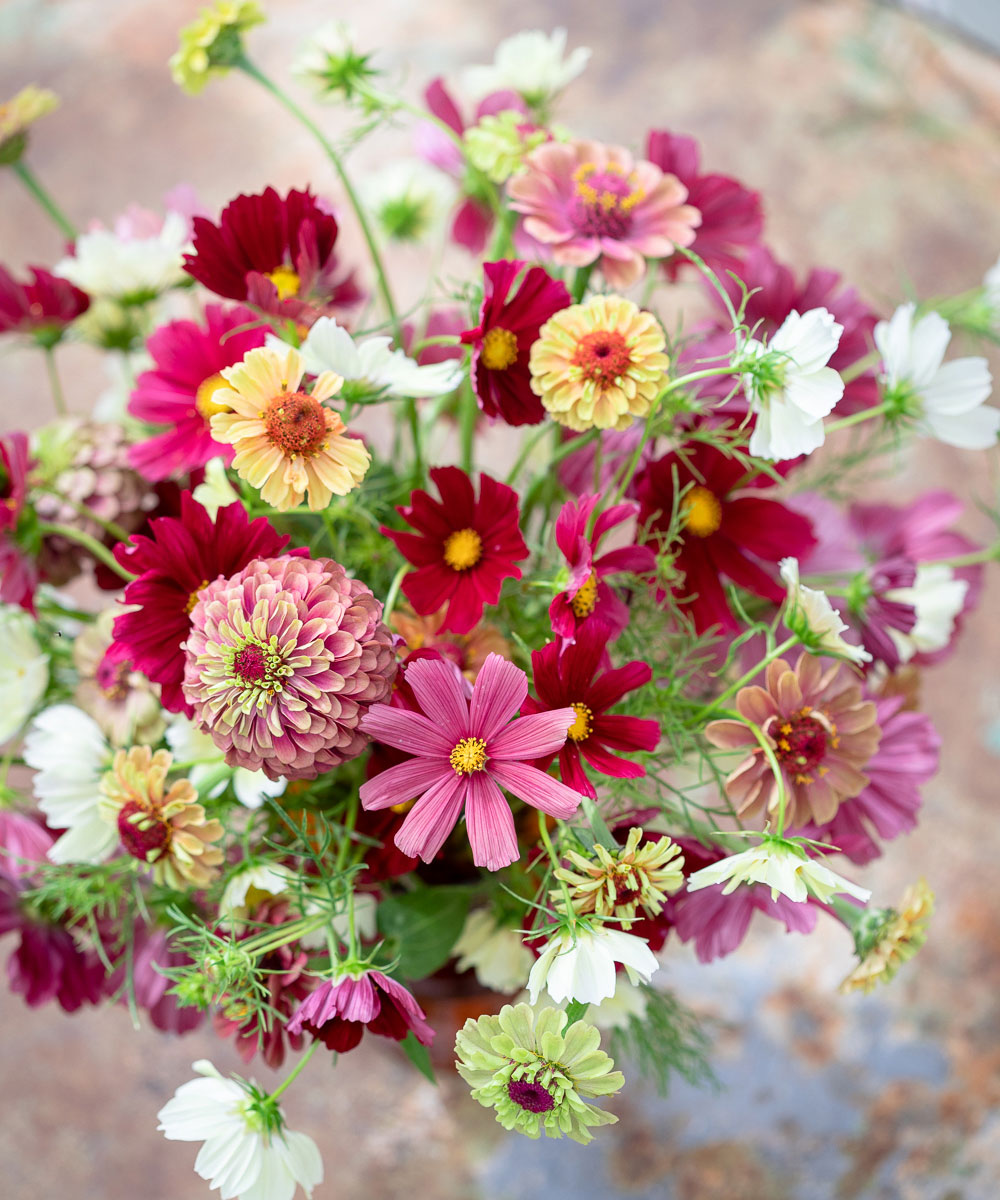
Sign up to the Homes & Gardens newsletter
Design expertise in your inbox – from inspiring decorating ideas and beautiful celebrity homes to practical gardening advice and shopping round-ups.

Having graduated with a first class degree in English Literature, Holly started her career as a features writer and sub-editor at Period Living magazine, Homes & Gardens' sister title. Working on Period Living brought with it insight into the complexities of owning and caring for period homes, from interior decorating through to choosing the right windows and the challenges of extending. This has led to a passion for traditional interiors, particularly the country-look. Writing for the Homes & Gardens website as a content editor, alongside regular features for Period Living and Country Homes & Interiors magazines, has enabled her to broaden her writing to incorporate her interests in gardening, wildlife and nature.
- Leigh ClappContributing Editor
-
 Should I choose a kitchen island or a kitchen table? This is the expert advice that helped me decide
Should I choose a kitchen island or a kitchen table? This is the expert advice that helped me decideIt's all about how you use your space
By Molly Malsom Published
-
 A $170 limited-time discount makes this the most affordable Dyson cordless vacuum on the market right now
A $170 limited-time discount makes this the most affordable Dyson cordless vacuum on the market right nowYears after its release, the Dyson V8 still impresses us with its features and power
By Dan Fauzi Published
-
 Water garden ideas – 9 ways to introduce soothing water to your outdoor space
Water garden ideas – 9 ways to introduce soothing water to your outdoor spaceFrom cascading fountains to wildlife ponds, there are plenty of ways to create a tranquil water garden
By Leigh Clapp Published
-
 How to grow poppies
How to grow poppiesFind out how to grow poppies to enjoy the beauty of these brightly colored tissue paper-like blooms
By Leigh Clapp Published
-
 How to grow delphiniums from seed
How to grow delphiniums from seedFind out how to grow delphiniums from seed and enjoy these colorful cottage garden favorites filling beds and borders
By Leigh Clapp Published
-
 How to grow ferns – when and how to plant and care for them
How to grow ferns – when and how to plant and care for themLearn how to grow ferns to enjoy the texture and form of these versatile plants in many areas of your garden
By Leigh Clapp Published
-
 How to grow sweet peas from seed – in borders and pots
How to grow sweet peas from seed – in borders and potsFind out how to grow sweet peas and where to enjoy their wonderful color, ruffled blooms and sweet fragrance in your garden
By Pippa Blenkinsop Published
-
 How to make fat balls for birds – easy steps feed our feathered friends
How to make fat balls for birds – easy steps feed our feathered friendsLearn how to make fat balls for birds to ensure their wellbeing throughout the winter
By Holly Reaney Published
-
 Planning a kitchen garden – from layouts to picking the best crops
Planning a kitchen garden – from layouts to picking the best cropsPlanning a kitchen garden is easy with this expert advice – whether yours is in beds, borders or a dedicated patch – you're guaranteed success
By Leigh Clapp Published
-
 How to grow cosmos – expert tips on when and where to plant these flowers
How to grow cosmos – expert tips on when and where to plant these flowersLearn how to grow cosmos to add bright color in your garden from summer through to fall with their beautiful blooms
By Leigh Clapp Published